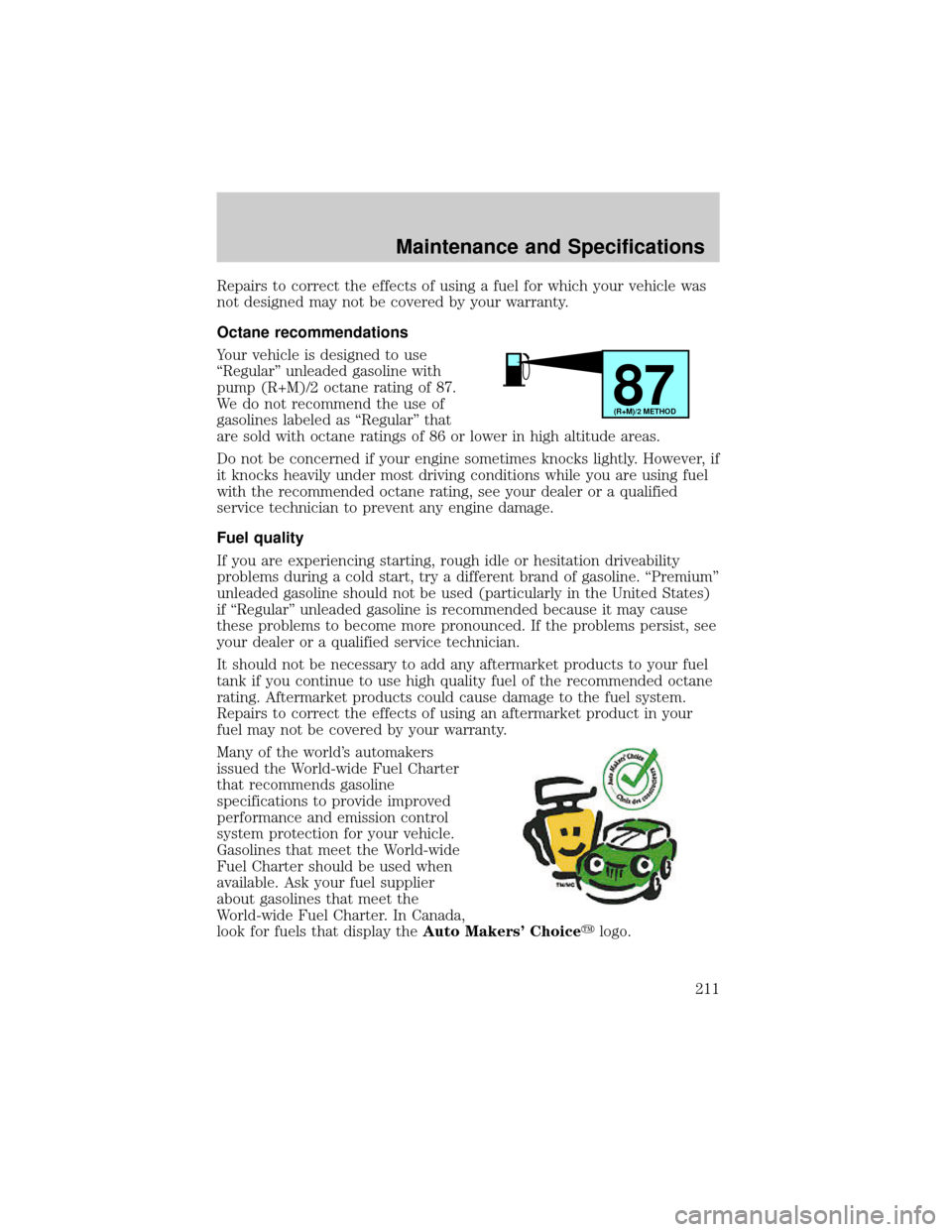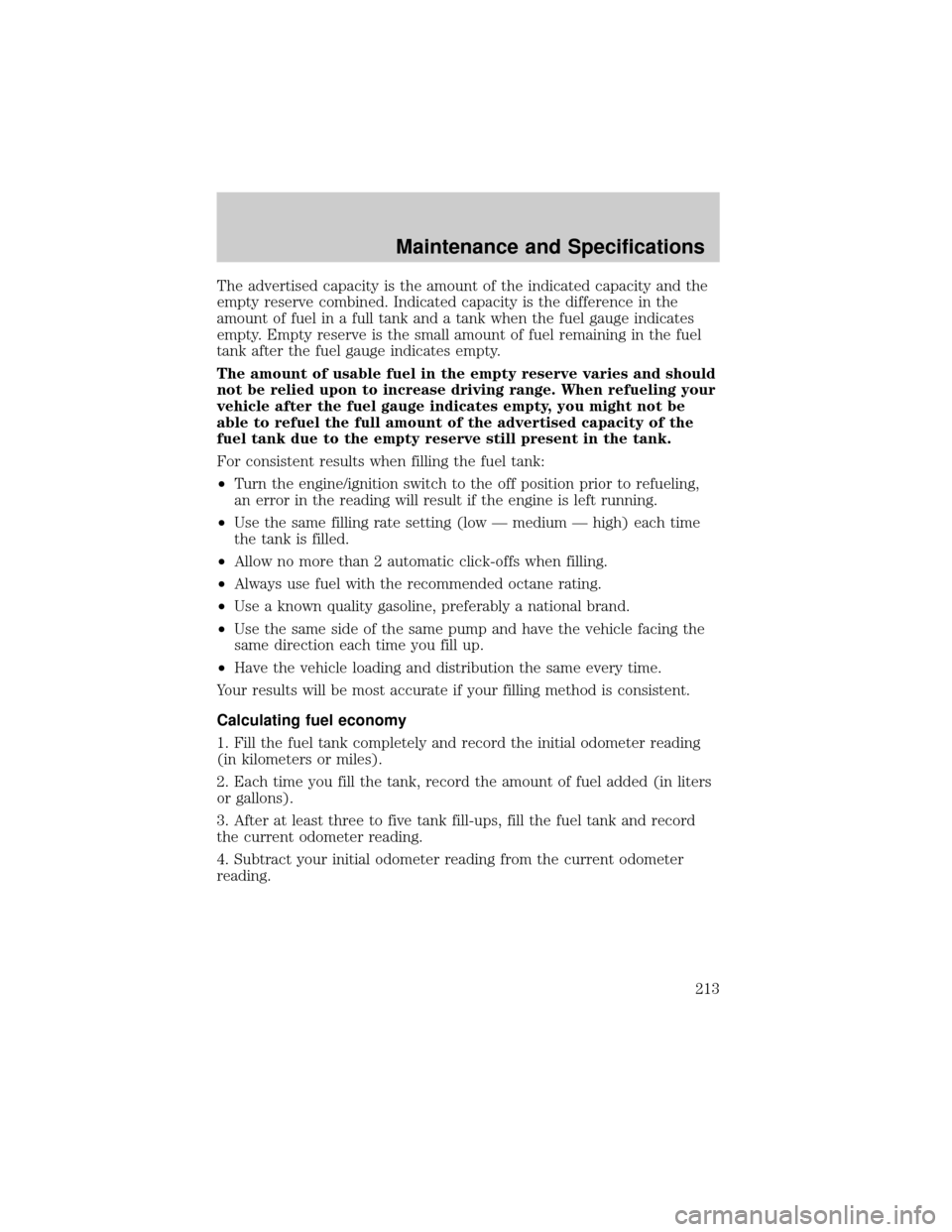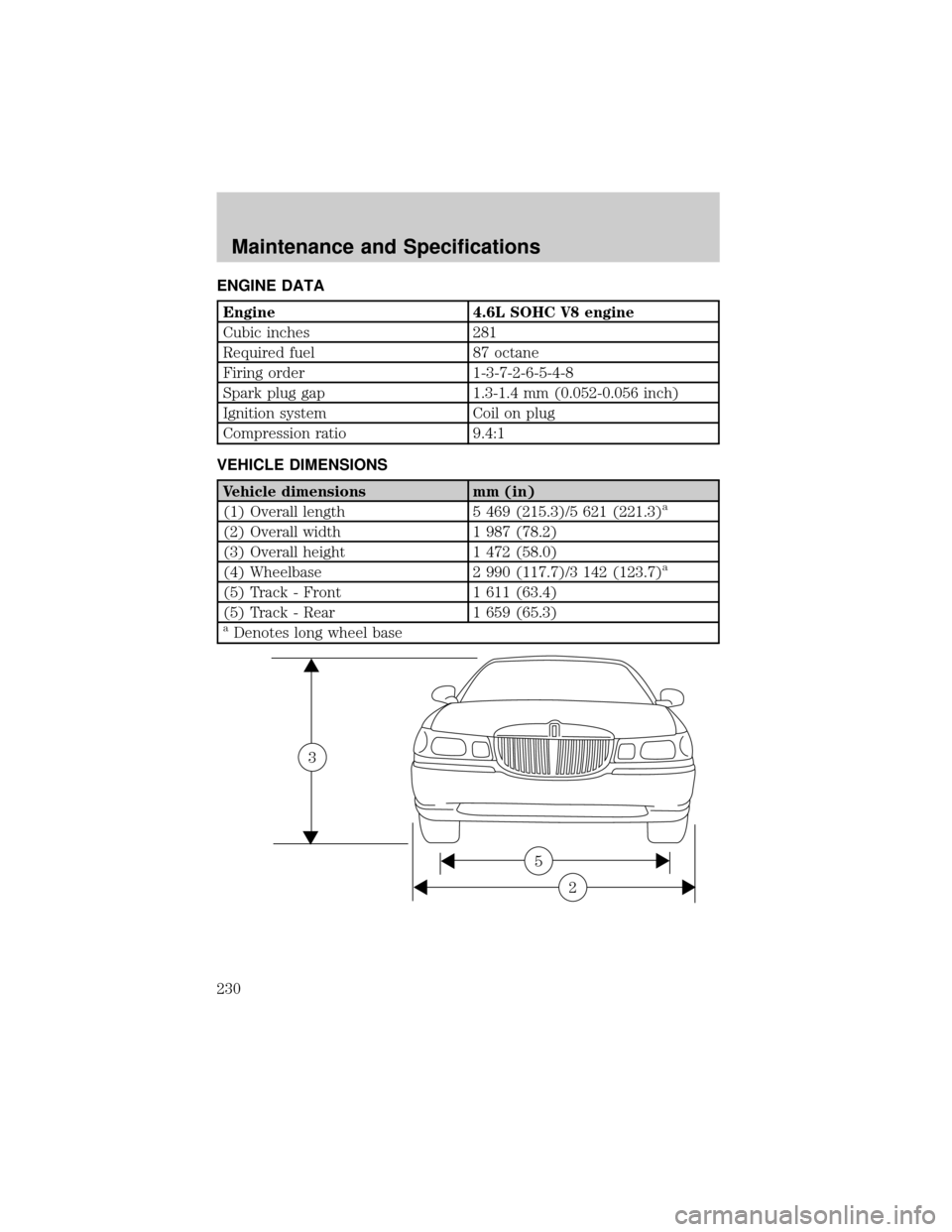octane LINCOLN TOWN CAR 2002 Owners Manual
[x] Cancel search | Manufacturer: LINCOLN, Model Year: 2002, Model line: TOWN CAR, Model: LINCOLN TOWN CAR 2002Pages: 248, PDF Size: 1.9 MB
Page 11 of 248

These temporary malfunctions can be corrected by filling the fuel tank
with high quality fuel of the recommended octane and/or properly
installing and securely tightening the fuel cap. After three driving cycles
without these or any other temporary malfunctions present, the light
should turn off. (A driving cycle consists of a cold engine startup
followed by mixed city/highway driving.) No additional vehicle service is
required.
If the light remains on, have your vehicle serviced at the first available
opportunity.
Light is blinking:
Engine misfire is occurring which could damage your catalytic converter.
You should drive in a moderate fashion (avoid heavy acceleration and
deceleration) and have your vehicle serviced at the first available
opportunity.
Under engine misfire conditions, excessive exhaust temperatures
could damage the catalytic converter, the fuel system, interior
floor coverings or other vehicle components, possibly causing a fire.
Check fuel cap
Illuminates when the fuel cap is not
installed correctly. Check the fuel
cap for proper installation. When
the fuel filler cap is properly
re-installed, the light(s) will turn off
after a period of normal driving. Continuing to operate the vehicle with
the check fuel cap light on, can activate theService Engine Soon/Check
Enginewarning light.
It may take a long period of time for the system to detect an
improperly installed fuel filler cap.
For more information, refer toFuel filler capin theMaintenance and
specificationschapter.
CHECK
FUEL
CAP
Instrument Cluster
11
Page 211 of 248

Repairs to correct the effects of using a fuel for which your vehicle was
not designed may not be covered by your warranty.
Octane recommendations
Your vehicle is designed to use
ªRegularº unleaded gasoline with
pump (R+M)/2 octane rating of 87.
We do not recommend the use of
gasolines labeled as ªRegularº that
are sold with octane ratings of 86 or lower in high altitude areas.
Do not be concerned if your engine sometimes knocks lightly. However, if
it knocks heavily under most driving conditions while you are using fuel
with the recommended octane rating, see your dealer or a qualified
service technician to prevent any engine damage.
Fuel quality
If you are experiencing starting, rough idle or hesitation driveability
problems during a cold start, try a different brand of gasoline. ªPremiumº
unleaded gasoline should not be used (particularly in the United States)
if ªRegularº unleaded gasoline is recommended because it may cause
these problems to become more pronounced. If the problems persist, see
your dealer or a qualified service technician.
It should not be necessary to add any aftermarket products to your fuel
tank if you continue to use high quality fuel of the recommended octane
rating. Aftermarket products could cause damage to the fuel system.
Repairs to correct the effects of using an aftermarket product in your
fuel may not be covered by your warranty.
Many of the world's automakers
issued the World-wide Fuel Charter
that recommends gasoline
specifications to provide improved
performance and emission control
system protection for your vehicle.
Gasolines that meet the World-wide
Fuel Charter should be used when
available. Ask your fuel supplier
about gasolines that meet the
World-wide Fuel Charter. In Canada,
look for fuels that display theAuto Makers' Choiceylogo.
87(R+M)/2 METHOD
Maintenance and Specifications
211
Page 213 of 248

The advertised capacity is the amount of the indicated capacity and the
empty reserve combined. Indicated capacity is the difference in the
amount of fuel in a full tank and a tank when the fuel gauge indicates
empty. Empty reserve is the small amount of fuel remaining in the fuel
tank after the fuel gauge indicates empty.
The amount of usable fuel in the empty reserve varies and should
not be relied upon to increase driving range. When refueling your
vehicle after the fuel gauge indicates empty, you might not be
able to refuel the full amount of the advertised capacity of the
fuel tank due to the empty reserve still present in the tank.
For consistent results when filling the fuel tank:
²Turn the engine/ignition switch to the off position prior to refueling,
an error in the reading will result if the engine is left running.
²Use the same filling rate setting (low Ð medium Ð high) each time
the tank is filled.
²Allow no more than 2 automatic click-offs when filling.
²Always use fuel with the recommended octane rating.
²Use a known quality gasoline, preferably a national brand.
²Use the same side of the same pump and have the vehicle facing the
same direction each time you fill up.
²Have the vehicle loading and distribution the same every time.
Your results will be most accurate if your filling method is consistent.
Calculating fuel economy
1. Fill the fuel tank completely and record the initial odometer reading
(in kilometers or miles).
2. Each time you fill the tank, record the amount of fuel added (in liters
or gallons).
3. After at least three to five tank fill-ups, fill the fuel tank and record
the current odometer reading.
4. Subtract your initial odometer reading from the current odometer
reading.
Maintenance and Specifications
213
Page 230 of 248

ENGINE DATA
Engine 4.6L SOHC V8 engine
Cubic inches 281
Required fuel 87 octane
Firing order 1-3-7-2-6-5-4-8
Spark plug gap 1.3-1.4 mm (0.052-0.056 inch)
Ignition system Coil on plug
Compression ratio 9.4:1
VEHICLE DIMENSIONS
Vehicle dimensions mm (in)
(1) Overall length 5 469 (215.3)/5 621 (221.3)a
(2) Overall width 1 987 (78.2)
(3) Overall height 1 472 (58.0)
(4) Wheelbase 2 990 (117.7)/3 142 (123.7)
a
(5) Track - Front 1 611 (63.4)
(5) Track - Rear 1 659 (65.3)
aDenotes long wheel base
2
5
3
Maintenance and Specifications
230
Page 239 of 248

lubrication
specifications ..................228, 230
refill capacities ........................227
service points ..........................194
starting after a collision .........157
Engine block heater .................139
Engine oil ..................................195
change oil soon warning,
message center .......................195
checking and adding ..............195
dipstick ....................................195
filter, specifications ........198, 226
recommendations ...................198
refill capacities ........................227
specifications ..................228, 230
Exhaust fumes ..........................139
F
Fail safe cooling ........................206
Floor mats ...................................87
Fluid capacities .........................227
Fuel ............................................207
calculating fuel
economy ............................80, 212
cap .....................................11, 209
capacity ...................................227
choosing the right fuel ...........210
comparisons with EPA fuel
economy estimates .................215
detergent in fuel .....................212
filling your vehicle with
fuel ...........................207, 209, 212
filter, specifications ........212, 226
fuel filler door override ............84
fuel filler door release ..............84
fuel pump shut-off switch .....157
gauge .........................................18
improving fuel economy ........212octane rating ...................211, 230
quality ......................................211
running out of fuel .................212
safety information relating to
automotive fuels .....................207
Fuses ..................................158±159
G
Garage door opener ....................69
Gas cap (see Fuel cap) ......11, 209
Gas mileage (see Fuel
economy) ...................................212
Gauges .........................................17
engine coolant temperature
gauge .........................................17
fuel gauge ..................................18
odometer ...................................18
speedometer .............................18
GAWR (Gross Axle Weight
Rating) .......................................150
definition .................................150
driving with a heavy load ......150
location ....................................150
GVWR (Gross Vehicle Weight
Rating) .......................................150
calculating ...............................150
definition .................................150
driving with a heavy load ......150
location ....................................150
H
Hazard flashers .........................157
Head restraints .........................102
Headlamps ...................................49
aiming ..................................51±52
autolamp system .......................49
Index
239
Page 241 of 248

Load limits .................................150
GAWR ......................................150
GVWR ......................................150
trailer towing ..........................150
Locks
autolock .....................................94
childproof ..................................88
doors ..........................................88
Lubricant specifications ...228, 230
Lumbar support, seats .............103
M
Message center ...........................77
english/metric button ...............82
reset button ..............................78
Mirrors .........................................61
automatic dimming rearview
mirror ........................................63
heated ........................................64
programmable memory ............94
side view mirrors (power) .......63
Moon roof ....................................69
Motorcraft parts ................212, 226
O
Octane rating ............................211
Odometer .....................................18
Oil (see Engine oil) ..................195
Overdrive .............................83, 148
P
Panic alarm feature, remote
entry system ................................91
Parking brake ............................142Parts (see Motorcraft parts) ....226
Passenger Occupant
Classification Sensor .................108
Pedals (see Power adjustable
foot pedals) .................................64
Power distribution box
(see Fuses) ...............................163
Power door locks ........................88
Power steering ..................144±145
fluid, checking and adding ....217
fluid, refill capacity ................227
fluid, specifications .........228, 230
R
Rear window defroster ...............48
Relays ........................................158
Remote entry system ...........90±91
illuminated entry ......................93
locking/unlocking doors ...........90
opening the trunk .....................91
panic alarm ...............................91
replacement/additional
transmitters ...............................93
replacing the batteries .............92
S
Safety belts (see Safety
restraints) ............16, 106, 110±114
Safety defects, reporting ..........185
Safety restraints ........106, 110±114
belt minder .............................116
cleaning the safety
belts .................................120, 191
extension assembly ................120
for adults .........................111±113
for children .....................128±129
Index
241